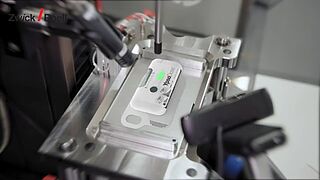ISO 11608-6: Testing of On-Body Delivery Systems (OBDS)
ISO 11608-6 describes the specific test requirements for testing on-body delivery systems (OBDS). All OBDS functions used during the application of the wearable injector must be tested. These include, for example, dosing accuracy, injection profile, actuation force, and audible signals. The goal is to determine reliable test results as a basis for development and robust quality assurance.
ISO 11608-6:Contents Typical test values What really matters Checklist Testing solution QualificationYpsomed reference Request a consultation
An on-body delivery system (OBDS) is an autoinjector worn on the body. OBDS are designed for the delivery of highly viscous biologics and larger injection volumes. They are attached to the patient's skin and can administer medication over a longer period of time than handheld autoinjectors or other needle-based injection systems.
OBDS are combination products. They have a reservoir for the medication, a needle for administration into the tissue, a drive system for delivering the appropriate amount of medication, operating, and display elements, and an adhesive surface for attaching the device to the patient's skin.
There are many names for on-body delivery systems: body-worn autoinjectors, wearable injectors, portable injection systems, bolus injectors, patch injectors and many more.
What exactly does ISO 11608-6 include?
Due to their specific application, OBDS have different testing requirements than handheld autoinjectors. Therefore, the separate standard ISO 11608-6 was introduced.
ISO 11608-6 includes:
- Test requirements such as dosing accuracy, injection time, injection profile and injection depth, with detailed information on determining and displaying dosing accuracy in Annex B
- For testing the automatic functions of the OBDS, it refers to ISO 11608-5
- Overview of the various test methods and standards for determining adhesive forces (Appendix A)
- ISO 11608-6 deliberately allows flexibility in the design of OBDS in order not to limit their diversity; however, the various design features and functionalities are, of course, taken into account in the risk assessment.
Together with the instructions for use in the package leaflet (IFU), ISO 11608-6 forms the basis for the risk assessment, which defines the individual testing requirements.
Typical test values for tests to ISO 11608-6
| Test value | Function | |
|---|---|---|
 | Actuation force | The force that the patient must exert to activate the OBDS. |
 | Audible signals / Click times | Audible signals indicate the start and end of the injection to the patient. The timing of these signals, which are usually audible as a "click," is recorded. |
 | Injection depth | The injection depth indicates the area of tissue into which the active ingredient is delivered. For an adhesive-wearable on-body delivery system (OBDS), it usually corresponds to the length of the visible needle. |
 | Injection time | The injection time describes the total time of dose delivery or individual dose intervals. See also injection time according to ISO 11608-6. |
 | Injection volume | The injection volume is the amount of injection delivered during the injection time. |
 | Injection profile | The injection profile compares the amount of adhesive dispensed to the injection time. |
 | Adhesive strength of the adhesive surfaces | Both the peel strength of the film and the adhesive strength on the patient's skin are determined. See also ASTM D3330, ISO 4578, EN 1939 |
Dosing accuracy according to ISO 11608-6
The dosing accuracy of the on-body delivery system is checked by measuring the injection volume. The injection volume is the total amount delivered to the patient. If the dose is delivered in several segments, each bolus is recorded individually. Both are displayed in the results documentation.
Various factors can distort the dosing accuracy result according to ISO 11608-6 and must therefore be prevented:
- Static influences distort the weighing result.
- Crystallization of biologicals upon contact with air.
- Evaporation reduces the weighed dose.
- Every last drop counts and must not be left in the needle or cannula.
The ZwickRoell OBDS testing solution eliminates these influences.
Injection time and injection profile to ISO 11608-6
The injection time or dose delivery time includes the time during which the total dose of the on-body delivery system is administered to the patient. In addition, the injection time of the individual segments is measured if the injection is carried out in several dose sections. Possible pauses or stops by the user are also taken into account.
The injection profile compares the delivered injection volume to the injection time. The testXpert testing software provides a clear overview of this.
OBDS diversity as a challenge
On-body delivery systems offer a wide variety of designs and functionalities. This diversity makes testing challenging, since the results should be comparable, and this is only possible if the same test conditions apply. To ensure comparable test results, a uniform test procedure is defined that takes the different characteristics into account.
The following OBDS characteristics are considered:
- Housing design
- Single or multiple use
- Functional sequences and scope of automatic functions
- Adhesive surface / fixation
- Medication container (cartridges/vials/refillable systems)
- Reservoir volume (range from 2 to 20 ml)
- Viscosity of the medication
- Delivery rate (for example, from 0.01 ml to over 60 ml per hour)
- Injection duration (from a few minutes to several hours)
- Possibly also communication via Bluetooth / NFC
Checklist for testing to ISO 11608-6
To ensure reliable test results, you should note the following points:
| What | Why | Solution | |
|---|---|---|---|
 | If possible, determine all test values in one test run on the same test specimen | Results are comparable and show lower tolerances if the OBDS is not changed for each value. Inaccuracies are reduced because the tester does not have to move the OBDS between different tests. This approach also saves a considerable amount of time. | Sequential test solution that achieves as many results as possible in a single test run |
 | Avoid static influences, crystallization, and evaporation | These factors affect the weighing result during injection, which compromises dosing accuracy. Static influences in particular have an unpredictable effect, leading to random deviations. | Exclusion via special technology |
 | Measurement including the last drop | For accurate determination of the injection volume to guarantee the therapeutically necessary dose. | Various techniques are available to capture the last drop |
 | High accuracy of the system | This requirement is best illustrated by the example of injection depth: This involves fractions of a millimeter, which are crucial in ensuring that the injection is made into the correct tissue layer. | High-resolution, camera-based measurement |
 | Minimize result variance due to operator influence | Operators can influence or even falsify test results: Non-intuitive processes, manual entries, different insertion of the specimen, and other individual interventions can lead to differences in results. | Significantly reducing operator influence, automatic processes, prepared test programs |
 | Eliminate sensor errors | If a sensor is found to be defective or misaligned only after testing, it can be costly—an entire batch may be affected by the results. | Daily Check for all sensors |
URS, DQ, IQ, OQ for OBDS-testing systems: Efficient planning and qualification
The effort required for the user requirements specification (URS) in the planning phase and for the entire qualification process is substantial. Take advantage of our experience and reduce your workload:
- User Requirement Specification (URS): For your user requirement specifications, you will receive a complete specification sheet from us, where you can go through the individual points step by step.
- Qualification: Our experienced in-house qualification team will take care of the qualification for you. With the special packages for design qualification (DQ), installation qualification (IQ) and operational qualification (OQ), you are in excellent hands.
- Traceability: our white paper provides assistance and answers all the important questions regarding FDA 21 CFR Part 11.
OBDS testing solution: All values in a single test run
It guarantees comparable test results because the sequential test solution determines all test values in one test run on the same specimen:
- Actuation force
- Detection of visual and audible signals before, during, and after injection
- Injection depth measured precisely using a camera with an accuracy of < 0.05 mm
- High-precision measurement of injection time and injection volume, recording of the injection profile
- Special or specific test methodology: Accurate weighing results without the influence of static charges, crystallization, or evaporation of the medication
- Time-synchronized video recording: Visual documentation of the entire injection process
Not only does it comply with ISO 11608-6, but the system is also compatible in accordance with the ZwickRoell FDA 21 CFR Part 11 white paper. Further information is available upon request.
testXpert testing software: Easy to use, flexible, and traceable
- Injector-specific test programs regulate the entire process. When changing injectors, the system simply calls up a different test program, which contains all the presets for the testing machine.
- Clear presentation of all results. testXpert integrates seamlessly into your processes through automated test reports or interfaces to your IT systems.
- Traceable and tamper-proof test results: testXpert is the perfect solution to help you meet FDA 21 Part 11 requirements.
- With the testXpert user management feature, you can assign corresponding rights to individual users. This way, users only see the tasks required to perform their job.
Determining adhesive strength in the second test area
Wearable injectors must be securely attached to the body. For this purpose, the adhesive forces on the patient's skin are determined. In addition, the peel forces for the protective film on the adhesive surface are determined to ensure simple but safe handling.
The adhesive force can be determined on the same specimen immediately after the functional test – it is not necessary to remove the OBDS test fixture. This is because, thanks to the second test area, the fixture for determining the adhesive force is also fixed in the testing machine. This makes switching between tests quick and easy, even in the testing software: All presettings for the respective test are stored in the testing software and are automatically retrieved, allowing you to switch between tests with a single click.
On the safe side with Daily Check
With these Daily Check tools, you can quickly check the proper operation of all test-relevant sensors on a daily basis:
- Daily Check for load cell
- Daily Check for camera based measuring systems
- Daily Check for scale
- Daily Check for microphone
- Customized Daily Check solutions
zwickiLine: flexible, compact, and reliable
The zwickiLine is modular and highly flexible. Thanks to its space-saving design, it fits easily into any laboratory. Test tools can be changed quickly and easily, and test conditions can be adjusted just as easily.
This makes it a popular choice for research and development as well as quality control. Close cooperation between our developers and our customers has ensured that the zwickiLine also reliably meets individual requirements.
The zwickiLine is also available as a cleanroom-compatible testing machine with the corresponding certificate.
Ypsomed Customer Case
Watch the video or read the case study to learn how close collaboration between Ypsomed and ZwickRoell led to the development of the clever OBDS testing solution—and how it was implemented at Ypsomed.



